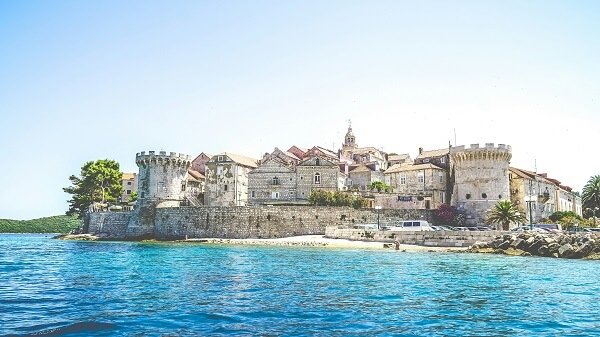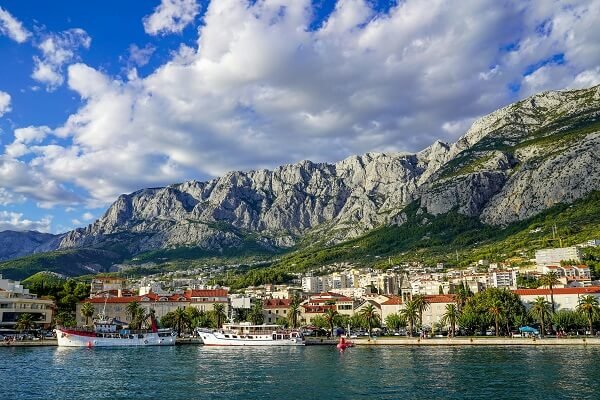
Knowing what to wear in Croatia can enhance your comfort and enjoyment during your visit.
I created a guide to help you dress appropriately for different occasions and locations as well as I shared a few tips for what gadgets you should pack up.
Preparation is half of the trip, and sometimes the only difference between a pleasant trip and a bad trip is the quality of the sandals you are wearing!
Casual Sightseeing
Let’s first share a few tips on what you should wear for casual sightseeing and exploring the Croatian streets.
Summer
Lightweight, breathable clothing such as shorts, skirts, dresses, and T-shirts will be your best bet.
Minimize the black color as it attracts the sun and trust me, with the temperatures rising to 104°F (40°C) the Mediterranean sun is not a joke.
Despite the heat, a sudden change in weather can make certain days dramatically colder, especially if you get hit by the notorious Croatian wind called bura.
Bura can reach a speed of 200 km/h (124.274 mph) and is considered one of the strongest winds in Europe.
If you are not prepared, don’t bring a jacket and long pants you’ll find yourself in a whole lot of trouble!
And finally, just as bura can make you uncomfortable, some regions of Croatia are notorious for sudden rain, predominantly in the Kvarner and Istria region, and less often, in Dalmatia.
Continental Croatia (Zagreb…) is cooler than the rest of Croatia, and while there’s no bura as bura is the wind created in the mountains that blows down to the sea, you should generally apply the same tips so as not to get surprised!
Spring/Fall
Layering is key. Bring a light jacket or sweater for cooler days and evenings. It’s usual that summer-like temperatures already begin in May, but temperatures are still unstable.
October in Croatia isn’t particularly cold, and it’s not unusual for people to swim in the sea until the 15th of October as real cold usually hits Croatia in November.
However, one thing is for sure, as soon as the fall season begins there are a lot of rain showers in the country.
Winter
I will be short here, winters are mild in Croatia, in Istria, Kvarner, and Dalmatia the average temperature during the day is between 5 and 10°C, but in continental Croatia such as in Zagreb, the average daily temperature is between -1 and 4C°.
So dress well and in those cozy coats, comfortable boots with gloves, hats, scarves, and anything else you think you’ll need to survive the cold!
Understanding the Croatian dress code
In Croatia, the dress code can vary depending on the setting and location. Here are some general guidelines:
Dress conservatively in certain settings
While Croatia is generally relaxed about clothing, it’s respectful to dress modestly when visiting religious sites or more traditional areas.
It’s also expected to dress up for restaurants instead of showing up in a bikini.
Moreover, wearing bikinis and not wearing a shirt in a town far from the beaches can be considered rude by locals.
Thus, it’s suggested that you always take some clothes with you and change after beach time and before returning to the town.
Leggings are generally acceptable
Leggings are commonly worn by both locals and tourists in Croatia, especially in casual settings or while exploring the cities.
Shorts are acceptable in most places
Shorts are perfectly fine to wear in Croatia, especially during the warmer months and in beach areas. However, it’s a good idea to opt for longer shorts when visiting more formal or conservative locations.
Crop tops are okay in casual settings
In beach towns and tourist areas, wearing crop tops is generally acceptable. However, in more conservative or formal settings, it’s advisable to opt for more modest attire.
Men often wear jeans
Jeans are a common wardrobe choice for men in Croatia, especially in urban areas and casual settings. They are versatile and suitable for various occasions, so you can never go wrong with jeans whether you are a man or a woman.
Overall, while Croatia is relatively relaxed in terms of dress code, it’s important to be mindful of cultural norms and dress appropriately for the specific occasion or location you’re visiting.
What to Wear to a Beach
While there’s no special beach dress code, it’s important to keep a few things in mind that will ensure you have a great time, just as following the beach etiquette will ensure others have a great time as well.

Wear sea shoes
While not necessary, sea shoes are a smart choice for almost every beach in Croatia.
I would advise that you buy a nice pair of sea shoes because there are many sea urchins on Croatian beaches and most beaches in Croatia are covered in pebbles instead of sand.
While it’s true that sea urchins are rarely located in the shallow waters near the shore, they can still surprise you near rocky reefs and if you are tall the odds are higher that you will encounter one.
Furthermore, pebbles aren’t the most comfortable terrain for walking barefoot!
Wear flip-flops
Flip-flops are just perfect when visiting a beach or taking a daily stroll near the sea as you never know when you’ll get a sudden urge to jump into the sea!
Flip-flops are flexible, and everybody wears them, from locals to tourists.
Plus, flip-flops and sandals are ideal for hot weather, don’t forget to apply some sun lotion to your toes because it sucks when you get them burnt!
A hat and sunglasses
Please don’t underestimate the Adriatic sun, it can be tough, and the UV waves are stronger than they used to be.
Wear a hat and sunglasses with UV protection to protect yourself, especially during the peak sunny hours between 12 pm and 4 pm.
Are clothes on beaches optional?
Wearing clothes on most Croatian beaches is mandatory, but there are plenty of nudist beaches where you can show up without clothes if you desire to!
What to wear in Croatia at night and to clubs?

In Croatia at night, especially when heading to clubs, it’s common to dress stylishly yet comfortably. Here are some suggestions for what to wear to clubs in Croatia:
- Dress in smart casual attire: Opt for fashionable clothing such as a stylish blouse or shirt paired with jeans or tailored trousers for a chic look.
- Choose comfortable footwear: Choose shoes you can dance in comfortably for hours, such as stylish sneakers, flats, or fashionable sandals.
- Consider the weather: Even during the summer you may want to bring a light jacket or shawl for cooler evenings. Don’t get surprised by the wind, after you exit the warmth of clubs or are sweaty after hours of dancing, the breeze can catch you off guard!
- Accessorize tastefully: Enhance your outfit with accessories like statement jewelry, a stylish belt, or a fashionable bag to complete your look.
- Be mindful of the club’s dress code: While this is rare in Croatia, some clubs may have specific dress codes, so it’s a good idea to check in advance to ensure your attire meets their requirements.
Overall, aim for a trendy and comfortable ensemble that reflects your personal style, and don’t worry about it!
Croatians like to dress well for clubs, restaurants, and evening strolls as after all we live near Italia and we have plenty of time to learn from the best.
Hiking and Outdoor Activities

And finally, let me share a few tips on what you should wear for hiking and outdoor activities in Croatia.
There is a trend of hikers making mistakes and not preparing properly before rushing their way through nature.
If you are interested in hiking I have a dedicated article where I share the best hiking spots in Croatia.
Appropriate Gear
Wear sturdy hiking shoes or trail runners for outdoor activities. You wouldn’t believe how many tourists hike in flip-flops, sandals, or other inappropriate shoes and then they realize they made a mistake and require a rescue.
Moreover, bringing enough water when hiking in Croatia is mandatory as in some regions you won’t find more water sources outside of the base camp.
Layered Clothing
Dress in layers for changing weather conditions, especially in mountainous areas.
It’s possible to find snow at mountain peaks even in the summer, and the temperature difference from the sea level and at 1600m can be 15°C.
And what’s even more important to notice is that you can get sunburns in the mountains even in the winter as the UV waves are always stronger at high altitudes.
Don’t forget these gadgets
Mosquito repellent
Despite the regular mosquito control programs, Croatia does have a problem with mosquitos.
While it’s true that mosquitos won’t bother you during sightseeing and taking an evening stroll through the town, you will encounter mosquitoes outside of the city’s centers, especially near forests, lakes, and the sea.
While it’s logical that you can’t avoid mosquitos when exploring nature, renting an apartment in the mosquito zone can be annoying as these little monsters will annoy you every time you get home.
Some type of mosquito repellent is a must!
Adapters and converters
When tourists visit Croatia, they may encounter the need for adapters and converters due to differences in electrical outlets and voltage standards compared to their home countries.
- Adapters: Electrical outlets in Croatia typically feature the European standard Type C outlets, which have two round pins. Tourists from countries with different outlet types, such as Type A (common in the United States) or Type G (common in the United Kingdom), will need adapters to plug in their electronic devices.
- Converters: In addition to adapters, tourists may also require voltage converters. Croatia operates on a 230-volt electrical system with a frequency of 50 Hz. Travelers from countries with different voltage standards, such as 120 volts in the United States, will need converters to safely use their devices without risking damage due to incompatible voltage.
You should check the electrical standards of Croatia before your trip and acquire the necessary adapters and converters to ensure a hassle-free experience.
Motion sickness relief
If you are planning island hopping, or taking trips across the sea, you might discover that you have seasickness.
Sometimes people don’t know they have seasickness, but on that one windy day when the waves are unusually large, they discover it the hard way.
Buying motion sickness medicine and carrying it in the bag in advance is a smart decision.
Conclusion
There you go, knowing what to wear when visiting a foreign country is fundamental knowledge.
Remember not to underestimate Croatian wind bura, sudden rain, and strong sun and you will be good.
Moreover, being aware of some common rules of the Croatian dress code such as wearing modest clothes in religious and formal settings will come in handy.
Have a nice trip and don’t wait until the last minute to pack up the stuff!
